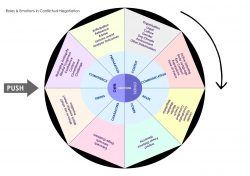Managing roles and emotions in conflict-heavy negotiations

While there is already abundant literature on the subject of ‘conflict’ and ‘negotiations’, over the last few years – by virtue of my profession – I have been involved in several conflictual negotiations and discussions that prompted me to capture my thoughts on this subject. I have been spending time reflecting on each of the discussions I had over the last few years and to explain this concept better, and capture all ingredients that go into this kind of a dialogue.
I thought of using the analogy of an octagonal wheel, as depicted in the figure below:
How fast the wheel will oscillate depends on the force with which it has been pushed. The force will depend upon how soon a result needs to be achieved, as depending on the conversation and other variable factors which make the push harder or more gentle. This is akin to we requiring an outcome either in the first confrontation or we are prepared to wait and achieve a result through a series of conversations in order to have a win-win outcome.
The octagonal wheel has several parts, the hub is the core of the wheel, the spokes, and the rim. At the heart of any negotiation is a set of emotions: fear, anger, contempt, sorrow, joy, pride, sadness, surprise, and so on. These emotions are displayed by all parties involved irrespective of whether it is two, three, or more people. Emotions are the core to any conflictual negotiation and akin to the hub in a wheel. The key element of achieving a successful dialogue in such circumstances is in managing emotions – controlling one’s own emotions and monitoring the emotions of others.
Then there are the eight robust spokes – the spokes carry the weight that is thrust onto the wheel and enable this burden to be distributed equally so that no one spoke is over-loaded. These spokes in a conflictual negotiation are presented below with a description of how they each play a key role in the eventual outcome.
The factor in a conflictual negotiation that corresponds to the rim, is the ability to deploy pressure on different spokes at different times in the negotiation, and also understanding how much pressure to apply where and when.
Preparation
Preparation is the starting point and essential spoke of the wheel. It entails anticipation of what the other stakeholder/s expect – their possible response to a proposition. It also involves doing your homework well. Learning from past lessons is not only restricted to previous similar negotiations but one’s involvement and experience of dealing with the stakeholders involved in various scenarios. It also means taking external specialist advice as required, speaking to points of reference within the organisation prior to the meeting, and doing a good analysis of the overall situation and intended outcomes – especially if it involves financial impact.
Context
This refers to the organisational environment. A lot of your decisions on management of emotions will depend on the context. The other variable factors governing a discussion are culture, organisational, national, as well as the individual specific culture of those participating in the dialogue. Then gender, if the people involved are from the same gender or different genders, will dictate a lot on which spokes will carry more or less thrust during the course of the conversation. There could be influence of other stakeholders as well on the context.
Communication
The communication style needs to vary greatly throughout the course of negotiations. It is important to build up a rapport early on and that means one has to be an active listener. The outcome depends a lot on your body language. Maintaining eye contact is key, and moderating your tone of voice is equally important. Your ability to be empathetic is just as important in making an effective pitch.
Roles
While negotiating it is also important to vacillate between different roles at different stages of discussion. You could be required to start off the meeting as a facilitator and let the others indulge in a discussion and then, as time progresses, move into the role of a leader, follower, or adviser. The roles people play in the negotiation process are strongly linked to the next spoke to be discussed.
Power
Power concerns both the actual power (hierarchy-based) as well as perceived power of those participating in a negotiation. Again, in some cultures the “Power Distance” between people from different organisation hierarchies could be very high, while in other country cultures it could be very low. The power element in fact influences even the amount of push that is likely to be exerted in giving the wheel momentum. The characters involved could vary greatly from being a client-subcontractor relationship, to a manager-subordinate relationship or a management representative dealing with a union leader. The impact of actual or perceived power of individuals dictates some of the other variables in a conflictual negotiation.
Characters
This refers to both numbers (how many are involved in the negotiation) as well as personalities. There could be instances of ‘introverts’ in a position of power, dealing with extroverts with less power or vice versa. Also there are bound to be personalities who are the so called “stage- grabbers” who need to be managed well, with influence on other spokes in the wheel.
Timing
Timing refers to the “when to say what”, and “which emotion when” questions of implementation. It is critical to transition well between different emotions, as well as roles that one has to play in a negotiation. Timing of the meeting is very closely linked to the ‘context’ spoke in the wheel.
Competence
Last, but not the least, is the competence of individuals involved. The ability to manage ambiguous situations courageously, mental toughness, and confidence to deliver are vital to a successful negotiation. Needless to say, the ability to communicate precisely, and being both transparent and convincing, are essential elements of a dialogue. Managing our own emotions as well as those of others is again a critical success factor.
In the end it is important to note that the analogy of a wheel has been used because when a conflictual negotiation is ongoing, the wheel oscillates, and the pressure moves from one spoke to another. It never remains on one and there is a vigorous interplay of emotions and movement of pressure from one spoke to the other.
As mentioned earlier, it also depends on what pace the wheel is moving at – so what force (push) has been exerted onto the wheel. There will be times, when the role of one spoke will be more dominant than the other, and it could also be intentional from both sides of the table. If any of the spokes is damaged, it could bring the wheel in motion to a grinding halt!
While this article has been written from the perspective of the conversation initiator, the interplay of emotions and thrust applied on each spoke is relevant to both parties involved. To summarise, the successful outcome of a conflictual negotiation will depend on all variables – starting from how much force has been exerted on the wheel towards an immediate outcome, the characters involved, the context in which the negotiation is happening and the hierarchy of representatives.
About the author
Nikhil Shahane is global people engagement director of TechnicFMC, a services provider to the Oil and Gas Industry, based in Houston in the US.





